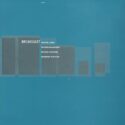Broadcast
| Track | Album |
|---|---|
| Colour Me In | Haha Sound |
| The Book Lovers | BBC Maida Vale Sessions |
| Lunch Hour Pops | Haha Sound |
| Man Is Not A Bird | Haha Sound |
| Subject To The Ladder | Tender Buttons |
| Where Youth And Laughter Go | Extended Play EP |
| The World Backwards | The Book Lovers EP |
| Make My Sleep His Song | Broadcast And The Focus Group Investigate Witch Cults... |
| I Found The F | Tender Buttons |
| Come On Let's Go | The Noise Made By People |

Contributor: Richard Stokoe
For some the first introduction to Broadcast would have been when hearing the track The Book Lovers while watching the 1997 movie Austin Powers: International Man Of Mystery. In many ways the music of Broadcast and a kitsch movie spoof about a flamboyant English spy in the 1960s is a perfect match, with the band’s influence coming partly from 60s psychedelia and the soundtracks of the TV programmes and movies of that era, not least the experimental and pioneering work of the BBC Radiophonic Workshop. But the link says nothing about the depth of their music.
The core duo of Trish Keenan and James Cargill formed the band at a time when looking to the past was in vogue but, unlike the Britpop acts around them, rather than taking their inspiration from mainstream pop bands like the Small Faces or the Kinks, they took a similar approach to Portishead and Stereolab, whose music, though influenced by the past, looked further afield for inspiration. In Broadcast’s case this meant taking a cut & paste approach, throwing varied influences together to produce a sound that was leftfield pop on the one hand, electronic experimentation on the other. For a child of the 70s it’s music that sounded vaguely familiar and could evoke memories of daytime kids TV shows about saggy old cloth cats & pink knitted creatures that lived on the moon, as well as the dystopian science fiction visions of a post-war Britain that was living in fear of a nuclear meltdown. In that sense it isn’t retro as much as it is retro-futurist, looking back to see the future reflected in the past.
I’m ashamed to say that I hadn’t really taken notice of Broadcast until I heard Marc Riley announce the tragic death of Trish Keenan in 2011. I knew of them but just hadn’t been paying attention, and that surprises me, even more so because I’d been a fan of Boards of Canada for a long time by then, and in a fundamental sense the two bands are cut from the same cloth. Both can be considered the godparents of hauntology, creating music that isn’t overtly menacing but that often has a hint of the sinister hidden within, at once current but also as if it could soundtrack childhood dreams and nightmares rooted in the Public Information films of the 1970s and 80s. Even now I can’t listen to tracks like Distorsion or Accidentals and not make a sub-conscious mental connection that reminds me that I should always say no to strangers, probably shouldn’t fly a kite near an electricity sub-station and shouldn’t even think about gathering up a bunch of friends to go and run amok at a local farmyard, at least not without the accompaniment of a responsible adult.
Given the cinematic influence and feel of the music, instead of listing the 10 tracks here in order of preference, I’ve tried to arrange them as if they were the soundtrack to an imaginary film. As evocative as it is, their music will mean something different to everyone, but in my case the film would be an amalgamation of Quatermass, Children Of The Stones and an episode of 1960s TV series The Avengers. It would be directed by Jean-Luc Godard and would at some point feature a hippy youth cult, a character wearing a bowler hat and permanently smoking a Gitanes, a double decker bus ride with a few clips of London landmarks stitched together as if they were all within a hundred yards of each other, a giant white rabbit, an abandoned nuclear power plant and a car chase through country lanes with a lot of shots of blurred hedgerows. As terrible as the film itself might be, it would be one of the best soundtracks I have ever heard.

Trish Keenan’s voice has a purity that renders it timeless, devoid of all colloquialism and affectation. She spoke in a broad Birmingham accent, but you could never tell that when she sang. It’s a voice that you could trust, perfect for singing a nursery rhyme and that’s exactly the quality that Colour Me In has.
It’s also the perfect example of the band’s knack of producing a song that can be both comforting and also vaguely disturbing. It sounds as though Keenan is singing in a fairground, so whilst the lyrics might seem childlike and innocent, all the while it feels as if there might be danger around the corner, an effect intensified by layers progressively added to music that starts out pleasantly tuneful and builds to an ominous and cacophonous din.
The Book Lovers is one of their better-known tracks, you can tell it’s one of their earlier songs because it sounds like a classic pop tune, their later work becoming a lot less commercial and more experimental. The harpsichord melody and sweeping orchestration make it the perfect addition to many a soundtrack, and the makers of Austin Powers obviously agreed. I’ve chosen the version they recorded for Radio 1’s Evening Session, taken from the BBC Maida Vale Sessions, as opposed to that included on The Book Lovers EP because there is a touch more urgency about it, which helps propel the song forward.
Lunch Hour Pops is an unusually jaunty tune that remains so from start to finish. Again, it has the feel of a nursery rhyme, with Keenan’s vocal melody accompanied by a cheery harp arpeggio, but although the song seems upbeat there is still a hint in the lyrics that all is not well.
The rhythm is the star for Man Is Not A Bird. Starting out as a straightforward motorik beat, it quickly collapses into a shuffling polyrhythmic groove, pioneering a new style of tribal jazz. This time Keenan’s lyrics don’t just hint at melancholy they shout it from the rooftops, but musically speaking it remains that, just a hint. The track is also a good example of a common ploy in Broadcast’s work, that of tacking on a bit of electronic tomfoolery onto the end of a song, in this case a minute’s worth of what sounds like an under-rehearsed version of the early 70s Hot Butter hit Popcorn, charming in its own way, and very Radiophonic Workshop.
By the time they recorded the album Tender Buttons in 2005 Broadcast had trimmed down to just the duo of Keenan and Cargill. As a result the sound is more stripped back, and where there is rhythm, acoustic drums are largely replaced by drum machines. In a 2005 Ben Cardew interview, Keenan explains that they felt they needed to produce something that was less in the shadow of the 60s bands, before going on to say, “We just turned off all the jewellery”. Subject To The Ladder is evidence of that more minimalist approach and proof that their sound was becoming less retro. They were by now creating a wholly modern take on psychedelia.
Back to their earlier catalogue, and a full band sound more in thrall to their original 60s influences, Where Youth And Laughter Go could fit comfortably on the Barbarella soundtrack or in an episode of The Prisoner. It’s a track of two halves, the first being a widescreen, melodic song embellished with sci-fi sound effects, the second a soporific groove offering the perfect segue into the next scene.
As previously mentioned, in their early years Broadcast didn’t just look to mainstream pop music for inspiration. The World Backwards has a waltzing, lounge-jazz feel with a hint of Françoise Hardy. They were much like their heroes The United States Of America in that respect, a band who, with their self-titled 1968 debut, broadened the scope of mainstream psychedelia and popular music in general. Their influence is obvious in Broadcast’s early work and, with its eerie instrumental interlude, this track is no exception.
Make My Sleep His Song is taken from Broadcast And The Focus Group Investigate The Witch Trials Of The Radio Age, their collaboration with Julian House aka The Focus Group and also co-owner the Ghost Box label, the spiritual home of all things hauntological. This is the band at their most atmospheric and reminds me of both Cocteau Twins’ Otterley and Linda Perhacs’ Parallelograms – I could get carried away here by saying that it sounds like a siren’s call to lost souls, but it does have that haunting, otherworldly quality. As such it taps into another feature of Broadcast’s music, that the frequent but subtle sense of unease suggests that some ancient evil is lurking within, and this track more than any recalls the acid folk of the psychedelic era, and The Wicker Man soundtrack in particular. Indeed, in a 2009 interview with Wire magazine, Keenan says of the song “This is a kind of LaVey lament where the female character is complicit in the strange event. I like those moments in British films like The Wicker Man and The Witches, when you’re not quite sure if the people of the village know all about the odd occurrences or not but an accidental citing or overheard conversation reveals that they are as much a part of the bizarre set up as the suspicious and aloof owner of the stately home.” Mother Is The Milky Way, their last full album as a duo, would go on to explore those avenues further.
In many ways I Found The F is quintessential Broadcast, an example of a track wholly built around the simplest of melodies, in this case a descending scale, an echo of which also kicks off the Witch Trials album. Unusually for Tender Buttons as a whole, the track features acoustic drums, with Keenan’s voice weaving itself around a repetitive beat and droning bass line, once again showing how important her vocals were as an instrument in itself.
Bringing the curtain down on this Top 10 is Come On Let’s Go, possibly their most commercial song, and a worthy track to accompany the closing credits to any story. I’m convinced that there is a cosmic void that exists for all those singles that should have been hits but weren’t. It will act like a holding tank, for its contents to be selected and re-released as and when the world has come to its senses and is ready to accept their magic, and it is then that they will take their rightful place among the great chart-toppers of the ages. But of course, these things don’t really matter.
It’s probably right that Come On Let’s Go only made it to number 82, that they remained a secret to those in the know. Broadcast dismissed the mainstream from the start. In an interview in 2000 with comedian Sean Hughes for Inside Tracks, Hughes asks, “In terms of chart success there doesn’t seem to be any room for quality music, how frustrating is that?” to which Trish Keenan replies “We’re better off out of commercial music.” In the 2005 interview with Ben Cardew she states, “I don’t know where we stand. We get good reviews but nobody buys it”.
And that’s Broadcast; existing in an orbit of their own making. With the passing of Trish Keenan the world lost a special talent and one of the great voices in modern music, and although James Cargill finished recording and released the soundtrack to the 2012 horror film Berberian Sound Studio under the Broadcast moniker after Keenan’s death, the band couldn’t continue without her. They are one of those bands that make me envy people who have yet to hear them, because, with the inclusion of three new retrospective releases this year, there is now an even larger back catalogue for them to explore. Their music will mean different things to different people, but to me it’s an escape, not to another world exactly, but to a version of this one that’s slightly skewed, and it’s all the better for it.

Future Crayon – Broadcast blog
Warp Records artist page – Broadcast
Children Of Alice (James Cargill post-Broadcast musical project)
The Focus Group (Julian House) website
Broadcast biography (AllMusic)
Richard Stokoe spent his formative years in Oxfordshire safe in the knowledge that quality music began and ended with The Wombles. He forgets how it happened but sometime in the mid-1970s it became apparent that this ‘truth’ proved to be nothing of the sort. In the meantime, and unbeknown to him, his family’s record collections had been quietly shaping his musical tastes, but again his world was turned upside down when, one day in the late 1970s, having heard Hong Kong Garden by Siouxsie & The Banshees on the TV, it transpired that quality music didn’t begin and end with Simon & Garfunkel, Genesis, Stevie Wonder and The Beatles. It is continual revelations such as these that have kept his passion for music alive ever since. He now lives in South London with his wife, cat, and an ever-expanding music collection, which still includes his original Wombles 45s. This is his music website Fuzzed Up and you’ll find him on twitter @RickStokoe
TopperPost #1,025









Follow